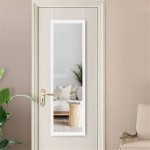Vintage Mirror Resilvering
Antique and vintage mirrors often suffer from a common ailment: deterioration of the reflective backing. This degradation, known as “foxing” or “black spot,” manifests as dark spots, hazy patches, or a complete loss of reflectivity. While these imperfections can add to a mirror's antique charm, they can also significantly diminish its functionality and aesthetic appeal. Resilvering offers a solution, restoring the mirror's original brilliance and preserving its historical value.
Resilvering is a process that involves replacing the deteriorated reflective layer of a mirror with a fresh coating. Historically, this reflective layer was made of silver nitrate, applied using a complex chemical process. Modern resilvering techniques continue to utilize silvering, but often incorporate advancements that enhance durability and longevity. Understanding the process, its benefits, and the factors influencing its cost can assist owners of antique mirrors in making informed decisions regarding their restoration.
The traditional method of resilvering mirrors involves a series of meticulous steps. First, the old, damaged silvering must be carefully removed. This is often achieved through a chemical stripping process that dissolves the silver nitrate without harming the glass substrate. Any remaining backing paint is then also removed, leaving a clean glass surface for the new silvering. The glass is thoroughly cleaned and prepared, ensuring no dust or contaminants interfere with the adhesion of the new silvering.
Once the glass is prepared, the resilvering process begins. This involves applying a solution containing silver nitrate to the glass surface. The silver nitrate reacts with other chemicals in the solution, causing a thin layer of metallic silver to deposit onto the glass. This delicate silver layer is what creates the reflective surface. After the silvering is complete, a protective copper coating is often applied, followed by layers of paint to seal and protect the newly silvered surface. This protective backing helps prevent future deterioration and extends the life of the resilvered mirror.
Modern resilvering techniques often utilize variations of this traditional process. Some methods employ spray application for a more even coating, while others incorporate protective sealant layers that offer enhanced resistance to environmental factors. The specific techniques utilized can impact the final result, affecting both the reflectivity and longevity of the restored mirror.
Choosing to resilver a vintage mirror offers several advantages. The most obvious benefit is the restoration of the mirror’s functionality. A resilvered mirror regains its reflective properties, allowing it to serve its intended purpose once again. Beyond functionality, resilvering also revitalizes the mirror’s aesthetic appeal. The removal of foxing and discoloration reveals the clarity and brilliance of the original glass, enhancing the overall beauty of the piece.
From a preservation standpoint, resilvering contributes to maintaining the historical integrity of the mirror. By addressing the deterioration of the reflective backing, resilvering prevents further damage and helps preserve the mirror for future generations. This is particularly important for antique mirrors that hold historical or sentimental value.
The cost of resilvering a vintage mirror can vary depending on several factors. The size of the mirror is a primary consideration, as larger mirrors require more materials and labor. The complexity of the mirror's design, including beveling, etching, or intricate framing, can also influence the cost. The extent of the damage to the existing silvering plays a role, as more extensive damage requires more preparation work. Finally, the specific resilvering technique employed by the restoration specialist can also affect the overall cost.
Locating a qualified professional for vintage mirror resilvering is crucial for ensuring a quality restoration. Seeking recommendations from antique dealers, conservators, or other professionals in the field can be helpful. It is essential to inquire about the specialist’s experience with antique mirrors and their specific resilvering techniques. Examining examples of their previous work can provide valuable insights into the quality and craftsmanship they offer.
Proper care and maintenance are essential for preserving a resilvered mirror. Avoiding excessive humidity and direct sunlight can help prevent future damage. Cleaning the mirror with a soft, lint-free cloth and a gentle cleaning solution designed for mirrors is recommended. Harsh chemicals or abrasive cleaners should be avoided, as these can damage the delicate silvering and protective coatings.
Resilvering offers a restorative solution for vintage mirrors suffering from the effects of time and deterioration. By understanding the process, its benefits, and the factors influencing its cost, owners of antique mirrors can make informed decisions about preserving these cherished pieces. Choosing a qualified professional and implementing proper care practices ensure the long-term beauty and functionality of the restored mirror.

Re Silvering Mirrors Doheny Mirror And Artistic Glass
Mirror Resilvering Frank Wright Glass

Antique Mirror Repair Fine Art Restoration Inc

Ep9 Antique Mirror Restoration

Antique French Giltwood Mirror Restoration Period Circa 1820 For At 1stdibs Near Me

Is Your Looking Glass Showing Age Twin Cities Bungalow Club

Re Silvering Mirrors Doheny Mirror And Artistic Glass

Antique Mirror Repair Fine Art Restoration Inc
Frank Wright Glass Services Mirror Resilvering

Restoration Ellison Art Glass








